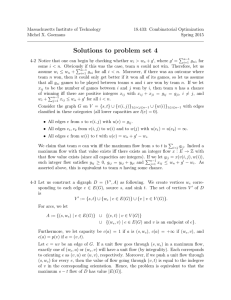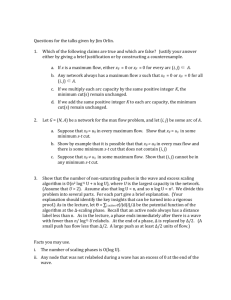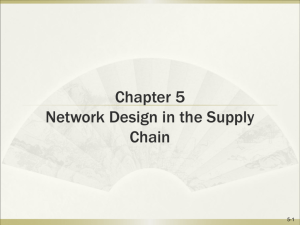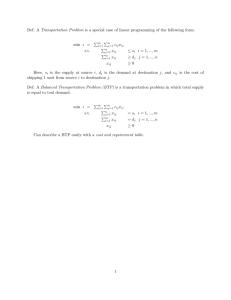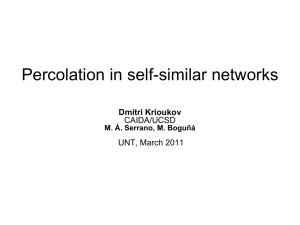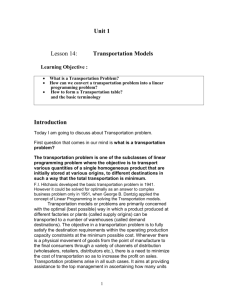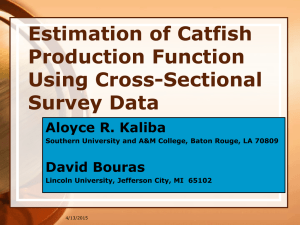Document 10812959
advertisement
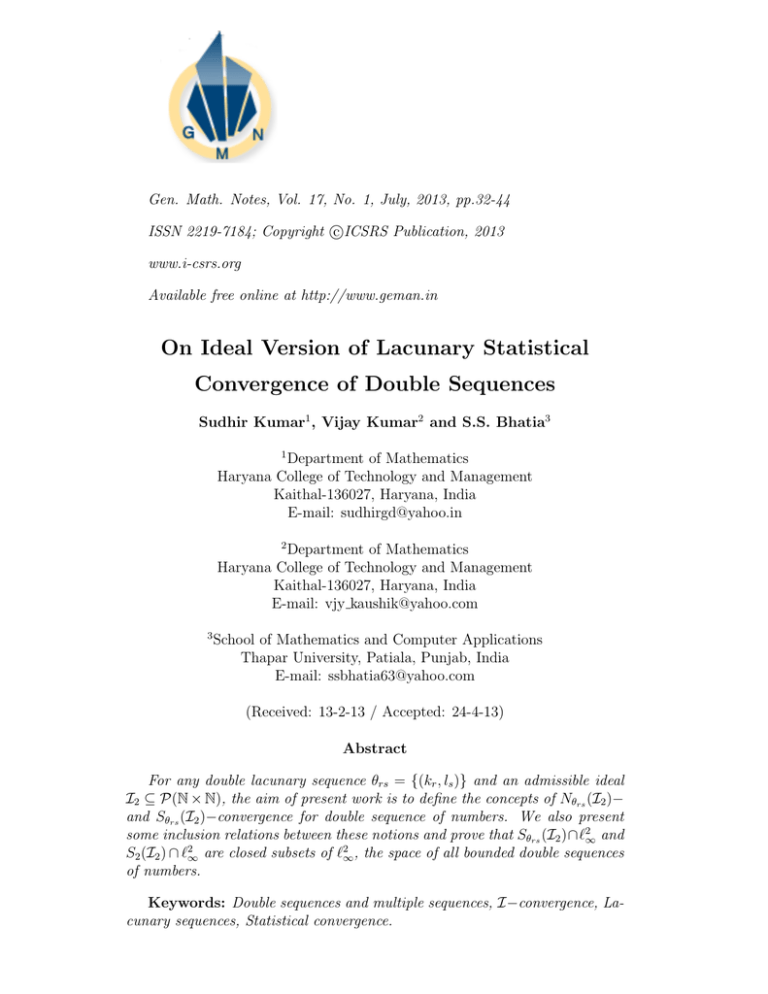
Gen. Math. Notes, Vol. 17, No. 1, July, 2013, pp.32-44
c
ISSN 2219-7184; Copyright ICSRS
Publication, 2013
www.i-csrs.org
Available free online at http://www.geman.in
On Ideal Version of Lacunary Statistical
Convergence of Double Sequences
Sudhir Kumar1 , Vijay Kumar2 and S.S. Bhatia3
1
Department of Mathematics
Haryana College of Technology and Management
Kaithal-136027, Haryana, India
E-mail: sudhirgd@yahoo.in
2
Department of Mathematics
Haryana College of Technology and Management
Kaithal-136027, Haryana, India
E-mail: vjy kaushik@yahoo.com
3
School of Mathematics and Computer Applications
Thapar University, Patiala, Punjab, India
E-mail: ssbhatia63@yahoo.com
(Received: 13-2-13 / Accepted: 24-4-13)
Abstract
For any double lacunary sequence θrs = {(kr , ls )} and an admissible ideal
I2 ⊆ P(N × N), the aim of present work is to define the concepts of Nθrs (I2 )−
and Sθrs (I2 )−convergence for double sequence of numbers. We also present
some inclusion relations between these notions and prove that Sθrs (I2 )∩`2∞ and
S2 (I2 ) ∩ `2∞ are closed subsets of `2∞ , the space of all bounded double sequences
of numbers.
Keywords: Double sequences and multiple sequences, I−convergence, Lacunary sequences, Statistical convergence.
On Ideal Version of Lacunary Statistical...
1
33
Introduction and Background
Fast[4] presented an interesting generalization of the usual sequential limit
which he called statistical convergence for number sequences. This idea turns
out very useful functional tool to resolve many convergence problems arising in
Fourier Analysis, Ergodic Theory, Number Theory and Analysis. In past few
years, statistical convergence is further investigated from the sequence space
point of view and linked with summability theory by Connor [2], Fridy [5],
Maddox [10], S̆alát [12] and many others.
Definition 2.1[4] A number sequence x = (xk ) is said to be statistically convergent to a number L (denoted by S − limk→∞ xk = L) provided that for every
> 0,
lim
n→∞
1
|{k ≤ n : |xk − L| ≥ }| = 0,
n
where the vertical bars denote the cardinality of the enclosed set. Let S denotes
the set of all statistically convergent sequences of numbers.
By a lacunary sequence, we mean an increasing sequence θ = (kr ) of positive integers such that k0 = 0 and hr = kr − kr−1 → ∞ as r → ∞. The
intervals determined by θ will be denoted by Ir = (kr−1 , kr ], where the ratio
kr
is denoted by qr .
kr−1
Using lacunary sequence, Fridy and Orhan [6] generalized statistical convergence as follows:
Definition 2.2[6] Let θ = (kr ) be a lacunary sequence. A sequence x = (xk ) of
numbers is said to be lacunary statistically convergent to a number L (denoted
by Sθ − limk→∞ xk = L) if for each > 0,
1
|{k ∈ Ir : |xk − L| ≥ }| = 0.
r−→∞ hr
lim
Let Sθ denotes the set of all lacunary statistically convergent sequences of numbers.
For any non-empty set X, P(X) denotes the power set of X.
A family of sets I ⊂ P(X) is called an ideal in X if and only if (i) ∅ ∈ I;
(ii) For each A, B ∈ I we have A ∪ B ∈ I; (iii) For A ∈ I and B ⊆ A we have
B ∈ I.
A non-empty family of sets F ⊂ P(X) is called a filter on X if and only
if (i) ∅ ∈
/ F; (ii) For each A, B ∈ F we have A ∩ B ∈ F; (iii) For A ∈ F and
B ⊇ A we have B ∈ F.
An ideal I is called non-trivial if I =
6 ∅ and X ∈
/ I.
It immediately implies that I ⊂ P(X) is a non-trivial ideal if and only if
the class F = F(I) = {X − A : A ∈ I} is a filter on X. The filter F = F(I)
is called the filter associated with the ideal I.
34
Sudhir Kumar et al.
A non-trivial ideal I ⊂ P(X) is called an admissible ideal in X if and only
if it contains all singletons i.e. if it contains {{x} : x ∈ X}. Throughout the
paper, I is considered as a non-trivial admissible ideal.
An admissible ideal I ⊂ P(X) is said to be satisfy the condition (AP ) if
for every countable family of mutually disjoint sets {A1 , A2 ...} belonging to I
there exists a countable family {B1 , B2 ...} in I such that Ai 4 Bi is a finite
set for each i ∈ N and B = ∪∞
i=1 Bi ∈ I.
Using the above terminology, Kostyrko et.al. [9] defined I−convergence in
a metric space as follows:
Definition 2.3[9] Let I ⊂ P(N ) be a non-trivial ideal in N and (X, ρ) be a
metric space. A sequence x = (xk ) in X is said to be I−convergent to ξ if for
each > 0, the set A() = {k ∈ N : ρ(xk , ξ) ≥ } ∈ I. In this case, we write
I − limk→∞ xk = ξ.
Recently, Das et.al. [3] unified the ideas of statistical convergence and
ideal convergence to introduce new concepts of I−statistical convergence and
I−lacunary statistical convergence as follows:
Definition 2.4[3] A sequence x = (xk ) of numbers is said to be I−statistical
convergent or S(I)−convergent to L, if for every > 0 and δ > 0
1
n ∈ N : |{k ≤ n : |xk − L| ≥ }| ≥ δ ∈ I.
n
In this case, we write xk → L(S(I)) or S(I) − limk→∞ xk = L. Let S(I)
denotes the set of all I−statistically convergent sequences of numbers.
Definition 2.5[3] Let θ = (kr ) be a lacunary sequence. A sequence x = (xk )
of numbers is said to be I−lacunay statistical convergent or Sθ (I)−convergent
to L, if for every > 0 and δ > 0
1
r ∈ N : |{k ∈ Ir : |xk − L| ≥ }| ≥ δ ∈ I.
hr
In this case, we write xk → L(Sθ (I)) or Sθ (I) − limk→∞ xk = L. The set of
all I−lacunary statistically convergent sequences will be denoted by Sθ (I).
Definition 2.6[3] Let θ = (kr ) be a lacunary sequence. A sequence x = (xk )
of numbers is said to be Nθ (I)−convergent to L, if for every > 0 we have
(
)
1 X
r∈N:
|xk − L| ≥ ∈ I.
hr k∈I
r
On Ideal Version of Lacunary Statistical...
35
It is denoted by xk → L(Nθ (I)) and the class of such sequences will be denoted
by simply Nθ (I).
In recent years, the above ideas of statistical convergence, lacunary statistical convergence and I−convergence have been respectively extended from
single to double sequences in [8], [11], [13], [14] and [15]. We now quote the
following definitions, which will be needed in the sequel.
Definition 2.7[11] A double sequence x = (xij ) of numbers is said to be
statistically convergent to a number L in the Pringsheim sense (denoted by
S2 − limi,j→∞ xij = L) provided that for every > 0,
P − lim
m,n→∞
1
|{i ≤ m, j ≤ n : |xij − L| ≥ }| = 0.
mn
In this case we write, S2 − P − limi,j→∞ xij = L. Let S2 denotes the set of all
double sequences, which are statistically convergent.
By a double lacunary sequence θrs = {(kr , ls )}, we mean there exists two
kr
,
lacunary sequences θr = (kr ) and θs = (ls ). Let hr = kr − kr−1 , qr = kr−1
ls
Ir = (kr−1 , kr ], hs = ls − ls−1 , q s = ls−1 , I s = (ls−1 , ls ], krs = kr ls , hrs = hr hs ,
qrs = qr q s and the interval determined by θrs is denoted by Irs = {(i, j) :
kr−1 < i ≤ kr , ls−1 < j ≤ ls }.
Definition 2.8[13] Let θrs be a double lacunary sequence. A double sequence
x = (xij ) of numbers is said to be lacunary statistically convergent to a number
L in the Pringsheim sense ( denoted by Sθrs − P − limi,j→∞ xij = L) if for each
> 0,
1
|{(i, j) ∈ Irs : |xij − L| ≥ }| = 0.
r,s→∞ hrs
P − lim
Let Sθrs denotes the set of all lacunary statistically convergent double sequences.
Definition 2.9[13] A double sequence x = (xij ) is said to be strongly Cesàro
summable to a number L if
m,n
1 X
|xij − L| = 0.
P − lim
m,n→∞ mn
i=1,j=1
)
m,n
1 X
|xij − L| = 0
x = (xij ) : ∃ someL, P − lim
m,n→∞ mn
i=1,j=1
(
Let
|σ11 | =
whereas |σ1 | denotes the space of all strongly Cesàro summable single sequences.
36
Sudhir Kumar et al.
Definition 2.10[13] Let θrs be a double lacunary sequence. A double sequence
x = (xij ) of numbers is said to be Nθrs − P −convergent to a number L if
1 X
|xij − L| = 0.
r,s→∞ hrs
P − lim
(i,j)∈Irs
Let Nθrs =
1
r,s→∞ hrs
x = (xij ) : ∃ some L, P − lim
X
(i,j)∈Irs
|xij − L| = 0 .
Definition 2.11[8] Let I2 ⊆ P(N×N) be a non-trivial ideal. A double sequence
x = (xij ) of numbers is said to be I2 − convergent in the Pringsheim sense to
a number L, if for every > 0
{(i, j) ∈ N × N : |xij − L| ≥ } ∈ I2 .
In this case, we write I2 − P − limi,j→∞ xij = L.
Definition 2.12[1] Let I2 ⊆ P(N×N) be a non-trivial ideal. A double sequence
x = (xij ) of numbers is said to be I2 −statistical convergent or S2 (I2 )−convergent
to L, if for each > 0 and δ > 0
1
(m, n) ∈ N × N :
|{1 ≤ i ≤ m, 1 ≤ j ≤ n : |xij − L| ≥ }| ≥ δ ∈ I2 .
mn
In this case, we write xij → L(S2 (I2 )) or S2 (I2 ) − P − limi,j→∞ xij = L. Let
S2 (I2 ) denotes the set of all I2 −statistically convergent double sequences of
numbers.
We now consider the lacunary statistical ideal convergence of double sequences, which we call Sθrs (I2 )−convergence of double sequences.
2
Main Results
Definition 3.1 Let θrs be a double lacunary sequence and I2 ⊆ P(N × N)
be a non-trivial ideal. A double sequence x = (xij ) of numbers is said to be
I2 −lacunary statistical convergent or Sθrs (I2 )−convergent to L, if for each
> 0 and δ > 0
1
(r, s) ∈ N × N :
|{(i, j) ∈ Irs : |xij − L| ≥ }| ≥ δ ∈ I2 .
hrs
On Ideal Version of Lacunary Statistical...
37
In this case, we write xij → L(Sθrs (I2 )) or Sθrs (I2 ) − P − limi,j→∞ xij = L.
Let Sθrs (I2 ) denotes the set of all I2 −lacunary statistically convergent double
sequences of numbers.
Definition 3.2 Let θrs be a double lacunary sequence and I2 ⊆ P(N × N)
be a non-trivial ideal. A double sequence x = (xij ) of numbers is said to be
Nθrs (I2 )−convergent to L, if for every > 0 we have
X
1
|xij − L| ≥ ∈ I2 .
(r, s) ∈ N × N :
hrs
(i,j)∈Irs
In this case, we write xij → L(Nθrs (I2 )) or Nθrs (I2 ) − P − limi,j→∞ xij = L.
Let Nθrs (I2 ) denotes the set of all Nθrs (I2 )−convergent double sequences of
numbers.
Example 3.1 If we take I2 = {E ⊂ N × N : E = (N × H) ∪ (H ×
N) for some finite subset H of N} and θr = (2r ), θs = (3s ) be two lacunary
sequences. We take a special set A ∈ I2 and define a sequence x = (xij ) by
p
√
√
ij, for (r, s) ∈
/ A, 2r−1 + 1 ≤ i ≤ 2r−1 + [ hr ] and 3s−1 + 1 ≤ j ≤ 3s−1 + [ hs ],
√
xij =
ij, for (r, s) ∈ A, 2r−1 < i ≤ 2r−1 + hr and 3s−1 < j ≤ 3s−1 + hs ,
0,
otherwise,
where Ir = (2r−1 , 2r ] and Is = (3s−1 , 3s ].
Then for each > 0, we have
p
√
[ hr ].[ hs ]
1
|{(i, j) ∈ Irs : |xij − 0| ≥ }| ≤
→0
P − lim
r,s→∞ hrs
hrs
for (r, s) ∈
/ A.
For δ > 0, there exists a positive integer r0 such that
1
|{(i, j) ∈ Irs : |xij − 0| ≥ }| < δ
hrs
for every (r, s) ∈
/ A and r, s ≥ r0 .
Let B = {1, 2, · · · r0 − 1} and K = {(r, s) ∈
/ A : h1rs |{(i, j) ∈ Irs : |xij − 0| ≥
}| ≥ δ}. Then clearly K ⊆ (N × B) ∪ (B × N) and K ∈ I2 by structure of
the ideal I2 . Hence
{(r, s) ∈ N × N :
1
|{(i, j) ∈ Irs : |xij − 0| ≥ }| ≥ δ} ⊂ A ∪ K.
hrs
It follows that Sθrs (I2 )−P −limi,j→∞ xij = 0. But similarly P −limr,s→∞ h 1h |{(i, j) ∈
r s
Irs : |xij − 0| ≥ }| 9 0. This example shows that Sθrs (I2 )−convergence is a
generalization of Sθrs −convergence for the double sequences.
38
Sudhir Kumar et al.
Theorem 3.1 For an admissible ideal I2 , Sθrs (I2 )−limit of any double sequence if exists is unique.
Theorem 3.2 Let I2 ⊆ P(N × N) be an admissible ideal and θrs be a double
lacunary sequence. Then, the set Sθrs (I2 ) is closed under the operations of
additions and scalar multiplication.
Proof The proof of this theorem is obvious.
The following theorem is a multidimensional analogue of Fridy and Orhan’s
theorem presented in [6].
Theorem 3.3 Let I2 ⊆ P(N × N) be an admissible ideal and θrs be a double
lacunary sequence. Then we have the following:
(i) xij → L(Nθrs (I2 )) implies xij → L(Sθrs (I2 )) ;
(ii)Nθrs (I2 ) is a proper subset of Sθrs (I2 );
(iii) If x = (xij ) ∈ `2∞ and xij → L(Sθrs (I2 )) then xij → L(Nθrs (I2 ));
(iv) Sθrs (I2 ) ∩ `2∞ = Nθrs (I2 ) ∩ `2∞ ;
where `2∞ denotes the space of all bounded double sequences.
Proof. (i) Suppose xij → L(Nθrs (I2 )). For > 0, we can write
X
(i,j)∈Irs
|xij − L| ≥
X
|xij − L|
(i,j)∈Irs &|xij −L|≥
≥ |{(i, j) ∈ Irs : |xij − L| ≥ }|;
which implies
X
1
1
|{(i, j) ∈ Irs : |xij − L| ≥ }|.
|xij − L| ≥
.hrs
hrs
(i,j)∈Irs
Thus for any δ > 0, we have the containment
1
(r, s) ∈ N × N :
|{(i, j) ∈ Irs : |xij − L| ≥ }| ≥ δ
hrs
X
1
⊆ (r, s) ∈ N × N :
|xij − L| ≥ δ .
hrs
(i,j)∈Irs
Since xij → L(Nθrs (I2 )), it follows that the later set belongs to I2 and hence
{(r, s) ∈ N × N : h1rs |{(i, j) ∈ Irs : |xij − L| ≥ }| ≥ δ} ∈ I2 . This shows that
xij → L(Sθr,s (I2 )).
39
On Ideal Version of Lacunary Statistical...
(ii) Let x = (xij ) be defined as follows:
1
2
3 ...
2
2
3 ...
..
..
..
..
. √.
.
.
xij = 2 [ 3 h ] . . . . . .
rs
0
0
0 0
..
..
..
..
.
.
.
.
√
3
[√
hrs ]
3
[ hrs ]
..
.
√
[ 3 hrs ]
0
..
.
0 ...
0 ...
.. ..
. .
0 ...
.
0 ..
.. . .
.
.
It is clear that (xij ) is an unbounded double sequence. Moreover, for each
>0
√
1
[ 3 hrs ]
|{(i, j) ∈ Irs : |xij − 0| ≥ }| ≤
hrs
hrs
which immediately implies for any δ > 0, the containment
1
(r, s) ∈ N × N :
|{(i, j) ∈ Irs : |xij − 0| ≥ }| ≥ δ
hrs
√
[ 3 hrs ]
⊆ (r, s) ∈ N × N :
≥δ .
hrs
√
[ 3 hr,s ]
Since P − lim hr,s = 0, it follows that the set on the right side is finite and
therefore belongs to I2 . This shows that
1
(r, s) ∈ N × N :
|{(i, j) ∈ Irs : |xij − 0| ≥ }| ≥ δ ∈ I2
hrs
and therefore we have xij → 0(Sθrs (I2 )). On the other hand
√
√
√
1 [ 3 hrs ]([ 3 hrs ]([ 3 hrs ] + 1))
1
1 X
|xij − 0| =
→ as r, s → ∞
hrs
hrs
2
2
(i,j)∈Irs
√
√
√
implies that the sequence ( h1rs [ 3 hrs ]([ 3 hrs ]([ 3 hrs ] + 1))) → 1 as r, s → ∞,
which gives for = 41
X
1
1
(r, s) ∈ N × N :
|xij − 0| ≥
hrs
4
(i,j)∈Irs
p
p
1 p
1
= (r, s) ∈ N × N :
[ 3 hrs ]([ 3 hrs ]([ 3 hrs ] + 1)) ≥
∈ F(I2 ).
hrs
2
This shows that xij → 0(Nθrs (I2 )) does not hold.
(iii) Suppose that x = (xij ) ∈ `2∞ such that xij → L(Sθrs (I2 )). Then there
40
Sudhir Kumar et al.
exists a M > 0 such that |xij − L| ≤ M for all (i, j) ∈ N × N. Also for each
> 0, we can write
1 X
1
|xij − L| =
hrs
hrs
(i,j)∈Irs
X
|xij − L| +
(i,j)∈Irs ,|xij −L|≥ 2
≤
1
hrs
X
|xij − L|
(i,j)∈Irs ,|xij −L|< 2
M
|{(i, j) ∈ Irs : |xij − L| ≥ }| + .
hrs
2
2
Consequently, we get
X
1
(r, s) ∈ N × N :
|xij − L| ≥
hrs
(i,j)∈Irs
1
|{(i, j) ∈ Irs : |xij − L| ≥ }| ≥
⊆ (r, s) ∈ N × N :
.
hrs
2
2M
Since xij → L(Sθrs (In2 )), it follows that the later set belongs oto I2 , which
P
immediately implies (r, s) ∈ N × N : h1rs (i,j)∈Irs |xij − L| ≥ ∈ I2 . This
shows that xij → L(Nθrs (I2 )).
(iv) This is an immediate consequence of (i) and (iii). Theorem 3.4 Let I2 ⊆ P(N×N) be an admissible ideal satisfying the condition
(AP ) and θrs be a double lacunary sequence such that θrs ∈ F(I2 ). If x =
(xij ) ∈ S2 (I2 ) ∩ Sθrs (I2 ) then S2 (I2 ) − P − limi,j→∞ xij = Sθrs (I2 ) − P −
limi,j→∞ xij .
Proof. Suppose S2 (I2 )−P −limi,j→∞ xij = L and Sθr,s (I2 )−P −limi,j→∞ xij =
0|
. Since I2 satisfies the condition (AP ),
L0 where L 6= L0 . Select 0 < < |L−L
2
so there is a set M = {(mp , nq ) : p, q = 1, 2, . . .} ⊆ N × N such that M ∈ F(I2 )
and
P − lim
p,q→∞
1
|{i ≤ mp , j ≤ nq : |xij − L| ≥ }| = 0.
mp nq
Let
A = |{i ≤ mp , j ≤ nq : |xij − L| ≥ }| and
B = |{i ≤ mp , j ≤ nq : |xij − L0 | ≥ }|.
Then mp nq = |A ∪ B| ≤ |A| + |B|, which implies that 1 ≤
|A|
mp nq
+ m|B|
. Since
p nq
limp,q→∞ m|B|
≤ 1 and limp,q→∞ m|A|
= 0, so we must have limp,q→∞ m|B|
= 1.
p nq
p nq
p .nq
?
?
Let M = M ∩ θrs , then M ∈ F (I2 ) and therefore an infinite set. Let
M ? = {(kαt , lβt0 ) : t, t0 = 1, 2, . . .}. Consider the (kαt lβt0 )th term of statistical
41
On Ideal Version of Lacunary Statistical...
limit expression
1
|{i
mp nq
≤ mp , j ≤ nq : |xij − L0 | ≥ }|;
1
|{i ≤ kαt , j ≤ lβt0 : |xij − L0 | ≥ }|
kαt lβt0
αt ,βt0
[
1
=
|{(i, j) ∈
Iuv : |xij − L0 | ≥ }|
kαt lβt0
u=1,v=1
1
=
kαt lβt0
αt ,βt0
X
|{(i, j) ∈ Iuv : |xij − L0 | ≥ }|
u=1,v=1
αt ,βt0
1
≤ ( Pαt ,β 0
t
u=1,v=1
)
huv
X
huv zuv (∗)
u=1,v=1
where zuv = h1uv |{(i, j) ∈ Iuv : |xij − L0 | ≥ }| → 0(I2 ) as Sθrs (I2 ) − P −
limi,j→∞ xij = L0 . Since θrs be a double lacunary sequence and (∗) satisfies all
the conditions for a four dimensional matrix transformation to map pringsheim
null sequence into pringsheim null sequence [7] and therefore it is also I2 −
convergent to zero as t, t0 → ∞ and so it has a subsequence which is convergent
to zero since I2 satisfies the (AP) condition. But since this is also a subsequence
1
|{1 ≤ i ≤ m, 1 ≤ j ≤ n : |xij − L0 | ≥ }|)(m,n)∈M , we infer that
of ( mn
1
{ mn
|{1 ≤ i ≤ m, 1 ≤ j ≤ n : |xij − L0 | ≥ }|} does not converge to 1. Which
is a contradiction. Hence L = L0 .
Next we give two results on the closed-ness of the sets Sθrs (I2 ) ∩ `2∞ and
S2 (I2 ) ∩ `2∞ out of which first is proved and the proof for the later can be
obtained similarly.
Theorem 3.5 The set Sθrs (I2 ) ∩ `2∞ is closed subset of `2∞ , the space of all
bounded double sequences endowed with the superior norm.
2
Proof Let xmn = (xmn
ij ) be a convergent sequence in Sθrs (I2 ) ∩ `∞ . Suppose
x(mn) converges to x. It is clear x ∈ `2∞ . Since x(mn) ∈ Sθrs (I2 ), therefore there
(mn)
exists Lmn such that Sθrs (I2 ) − P − lim xij = Lmn (m, n = 1, 2, 3, . . .). As
x(mn) → x implies x(mn) is a Cauchy sequence. So for each > 0, there exists
a positive integer n0 such that for every p ≥ m ≥ n0 , q ≥ n ≥ n0 , we have
|x(pq) − x(mn) | < .
3
(mn)
(1)
Since xij → Lmn (Sθrs (I2 )), therefore for every > 0 and δ > 0, if we denote
the sets
1
δ
mn
K1 = (r, s) ∈ N × N :
|{(i, j) ∈ Irs : |xij − Lmn | ≥ }| <
and
hrs
3
3
1
δ
pq
K2 = (r, s) ∈ N × N :
|{(i, j) ∈ Irs : |xij − Lpq | ≥ }| <
,
hrs
3
3
42
Sudhir Kumar et al.
then φ 6= K1 ∩ K2 ∈ F (I2 ). Let (r, s) ∈ K1 ∩ K2 , then we have h1rs |{(i, j) ∈
δ
δ
Irs : |xmn
and h1rs |{(i, j) ∈ Irs : |xpq
ij − Lmn | ≥ 3 }| < 3
ij − Lpq | ≥ 3 }| < 3 ,
which implies that
1
|{(i, j) ∈ Irs : |xmn
∨ |xpq
ij − Lmn | ≥
ij − Lpq | ≥ }| < δ < 1.
hrs
3
3
This shows that there exists a pair (i0 , j0 ) ∈ Ir,s for which |xmn
i0 j0 − Lmn | < 3
and |xpq
i0 j0 − Lpq | < 3 . Moreover, for p ≥ m ≥ n0 and q ≥ n ≥ n0 , we have
pq
mn
mn
|Lpq − Lmn | = |Lpq − xpq
i0 j0 | + |xi0 j0 − xi0 j0 | + |xi0 j0 − Lmn | < 3 + 3 + 3 = .
Thus (Lmn ) is a Cauchy double sequence in R(orC) and consequently there is
a number L such that Lmn −→ L as m, n −→ ∞. Now to prove the theorem
it is sufficient to show that the sequence x = (xij ) −→ L(Sθrs (I2 )). Since
xmn is convergent to x ∈ `2∞ so by the structure of `2∞ , it is coordinate-wise
convergent. Therefore for each > 0, there exists a positive integer n1 () such
that
(2)
|xmn
ij − xij | < , ∀ m, n ≥ n1 ().
3
Also Lmn → L, so for each > 0, we can find another positive integer n2 ()
such that
|Lmn − L| < , ∀ m, n ≥ n2 ().
(3)
3
Choose n3 () = max {n1 (), n2 ()} and m0 , n0 ≥ n3 (). Then for any (i, j) ∈
N×N
(m n )
(m n )
|xij − L| ≤ |xij − xij 0 0 | + |xij 0 0 − Lm0 n0 | + |Lm0 n0 − L|
(m n )
< + |xij 0 0 − Lm0 n0 | + (by (2) and (3))
3
3
and therefore the containment
0 n0
{(i, j) ∈ Irs : |xij − L| ≥ } ⊆ {(i, j) ∈ Irs : |xm
− Lm0 n0 | ≥ }implies
ij
3
1
1
m0 n0
|{(i, j) ∈ Irs : |xij − L| ≥ }| ≤
|{(i, j) ∈ Irs : |xij − Lm0 n0 | ≥ }|.
hrs
hrs
3
Further, for any δ > 0 we have
1
m0 n0
(r, s) ∈ N × N :
|{(i, j) ∈ Irs : |xij − Lm0 n0 | ≥ }| < δ ⊆
hrs
3
1
(r, s) ∈ N × N :
|{(i, j) ∈ Irs : |xij − L| ≥ }| < δ .
hrs
n
o
0 n0
Since (r, s) ∈ N × N : h1rs |{(i, j) ∈ Irs : |xm
−
L
|
≥
}|
<
δ
∈ F (I2 )
m0 n0
ij
3
so
On Ideal Version of Lacunary Statistical...
n
(r, s) ∈ N × N :
1
|{(i, j)
hrs
43
o
∈ Ir,s : |xij − L| ≥ }| < δ ∈ F (I2 ). Hence {(r, s) ∈
N × N : h1rs |{(i, j) ∈ Irs : |xij − L| ≥ }| ≥ δ} ∈ I2 . This shows that
x = (xij ) → L(Sθrs (I2 ). Which completes the proof of the theorem.
Theorem 3.6 The set S2 (I2 ) ∩ `2∞ is closed subset of `2∞ , the space of all
bounded double sequences endowed with the superior norm.
References
[1] C. Belen and M. Yilldirim, On generalized statistical convergence of double sequences via ideals, Ann Uni Ferrara, 58(2012), 11-20.
[2] J. Connor, The statistical and strong p−Cesa0 ro convergence of sequences,
Analysis, 8(1988), 47-63.
[3] P. Das, E. Savas and K. Ghosal, On generalizations of certain summability
methods using ideals, Appl. Math. Letters, 24(2011), 1509-1514.
[4] H. Fast, Surla convergence statistique, Colloq Math., 2(1951), 241-244.
[5] J.A. Fridy, On statistical convergence, Analysis, 5(1985), 301-313.
[6] J.A. Fridy and C. Orhan, Lacunary statistical convergence, Pacific J.
Math., 160(1993), 43-51.
[7] H.J. Hamilton, Transformations of multiple sequences, Duke Math. J.,
2(1936), 29-60.
[8] V. Kumar, I and I ∗ − convergence of double sequences, Math Commun.,
12(2007), 171-181.
[9] P. Kostyrko, T. S̆alát and W. Wilczynski, I−convergence, Real Anal Exchange, 26(2000), 669-686.
[10] I.J. Maddox, Statistical convergence in a locally convex sequence space,
Math Proc Cambridge Philos Soc., 104(1988), 141-145.
[11] M. Mursaleen and O.H. Edley, Statistical convergence of double sequences,
J Math Anal Appl., 288(2003), 223-231.
[12] T. S̆alát, On statistically convergent sequences of real numbers, Math
Slovaca, 30(1980), 139-150.
[13] E. Savas and R.F. Patterson, Lacunary statistical convergence of multiple
sequences, Appl Math. Letters, 19(2006), 527-534.
44
Sudhir Kumar et al.
[14] V.A. Khan and S. Tabassum, On some new almost double lacunary
∆m −sequence spaces defined by Orlicz functions, Gen. Math. Notes,
6(2011), 80-94.
[15] V.A. Khan and S. Tabassum, The strongly summable generalized difference double sequence spaces in 2-normed spaces defined by an Orlicz
functions, Gen. Math. Notes, 7(2011), 45-58.
